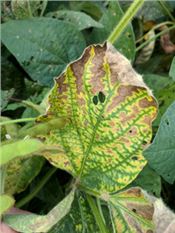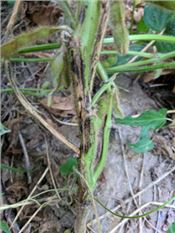|
Is It Soybean Stem Canker…Or Something Else?
DR. KIERSTEN WISE AND DR. CARL BRADLEY
PRINCETON, KY.
Several issues in soybean can cause leaf tissue to turn yellow and brown between the veins, while the veins remain green. These symptoms are known as interveinal chlorosis and necrosis. This article describes some of the diseases and disorders currently causing interveinal chlorosis and necrosis in Kentucky soybean fields.
Potential Diseases & Disorders
Stem Canker
Stem canker, caused by Diaporthe spp., is characterized by a brown discoloration on mid- to lower stems, usually first observed where branches meet stems (Figure 1). Although foliar symptoms are not always present, stem canker can cause interveinal chlorosis and necrosis on upper leaves (Figure 2). Foliar symptoms are not typically observed without the presence of cankers on stems, which can help diagnosis this disease. These cankers can enlarge and spread along stems, causing large areas of discoloration. Stem canker can cause soybeans to die early, leaving patches of dead plants in a field.
Different species of Diaporthe fungi can cause stem canker, and there are two main stem canker diseases that occur in the U.S., known as northern and southern stem canker. In the 2016 growing season, southern stem canker wreaked havoc on some very susceptible varieties that were grown in a few fields in western Kentucky. Once again in 2017, southern stem canker can be observed in some fields in the state. Severe cases of southern stem canker are more likely to be observed in fields that were planted to soybean in consecutive years, on susceptible varieties, and in areas where rainfall has been abundant.
Sudden Death Syndrome &
Brown Stem Rot
Other soybean diseases that can cause interveinal chlorosis and necrosis include sudden death syndrome and brown stem rot. Sudden death syndrome (SDS) is commonly observed in Kentucky, but brown stem rot is a disease typically observed in states north of Kentucky, and would not likely be observed here.
No symptoms on the outside of the stem will be present with either sudden death syndrome or brown stem rot. The primary symptom of sudden death syndrome is the interveinal chlorosis and necrosis, but the cortex (area outside of the pith, which is in the middle) of lower stems and taproots may have a brown discoloration. A root rot (brown-colored roots) also may be associated with sudden death syndrome. As sudden death syndrome progresses, leaves will drop from plants, leaving petioles intact. Although brown stem rot is not likely to occur in Kentucky, stems should be split open to rule out this disease. In addition to the interveinal symptoms on the leaves (described above), piths (most internal portion of stems) of plants affected by brown stem rot will have a brown discoloration.
Fungicide Phytotoxicity
When certain triazole fungicides are applied to soybean, especially in hot and dry conditions, interveinal chlorosis and necrosis of the leaves also may appear. Unlike what may be observed with the diseases described above, these leaf symptoms will not progress over time, and new leaves will not be affected. University research results suggest that yield losses caused by triazole fungicide phytotoxicity are not likely to occur. Stem and root symptoms described for the diseases above will not be a result of triazole fungicide applications.
Yield Loss & Management Options
The amount of yield loss expected from stem canker and SDS will vary and depends on variety susceptibility, the growth stage at which symptoms appeared, and symptom severity.
No in-season management options are effective against stem canker or sudden death syndrome. Because the pathogens that cause these diseases survive in residue and soil, selecting resistant varieties for the next soybean planting is the first step for management. Rotating away from soybean can also help reduce the amount of inoculum available.
More details on disease management practices for each disease, including tables that compare and contrast the symptoms of these diseases and disorders are described in the Crop Protection Network publications Stem Canker, and Sudden Death Syndrome. ∆
DR. KIERSTEN WISE: Extension Associate Professor, University of Kentucky
DR. CARL BRADLEY: Extension Plant Pathologist, University of Kentucky

Figure 1. Discoloration on the mid to lower stem
of soybean is characteristic of stem canker

Figure 2. Stem canker can cause interveinal chlorosis and necrosis that can
be confused with other diseases and disorders
|
|